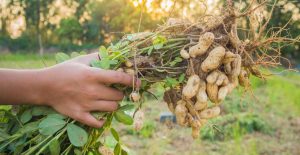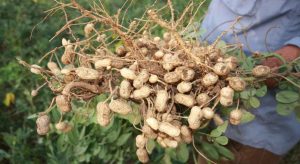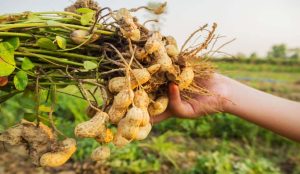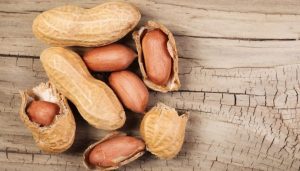Ever wonder why peanuts and tree nuts are two of the top eight allergens? Do you sometimes think that peanuts are nuts?
You don’t even know what a tree nut is, do you? If you’ve ever wondered this, as I have, this post tells you everything you need to know about nuts.
Even though the peanut’s name includes the word “nut,” it’s not really a nut.

It’s really a type of bean. Peanuts are in the same family as beans, lentils, and peas. They are legumes, which are seeds in pods that can be eaten.
On the other hand, nuts that grow on trees include walnuts, cashews, almonds, and pecans, among others.
In terms of botany, all tree nuts are nuts, but not all nuts are tree nuts. Some tree nuts are drupes.
I know it’s hard to understand, so let me try to explain. The definition of a nut is a hard-shelled pod that contains both the fruit and seed of the plant. Hazelnuts and acorns belong to this group.
Drupes are fruits that have a hard, stony shell around the seed. Drupes have three layers: the exocarp on the outside, the mesocarp in the middle, which is the fleshy part, and the endocarp, which is the hard, woody part around the seed.
Peaches, mangoes, pistachios, coconuts, almonds, and cashews are all examples of drupes.
When it comes to allergens, there are different ways to talk about tree nuts. As I said above, they are any nut that grows on a tree or a nut as it is commonly known.
They include almonds, hazelnuts, pecans, walnuts, cashews, chestnuts, coconuts, and a lot of other nuts and drupes.
So, if you are allergic to tree nuts, you might not be able to eat coconuts, but not mangoes. And just because you’re allergic to walnuts doesn’t mean you’re also allergic to all tree nuts.
When it comes to putting labels on food, all of this is important. If a food or food product has tree nuts in it, it might say “tree nuts” or it might say the type of nut it has. If it’s the latter, you should avoid it because you don’t know which tree nut it is.

peanut tree
Peanuts have a flavor and nutritional profile that are comparable to other tree nuts, such as walnuts and almonds, and as culinary nuts, they are typically prepared and served in a manner that is analogous to how these other tree nuts are.
Botanically speaking, a nut is a fruit whose ovary wall gets hard when it reaches maturity. According to this definition, a peanut does not qualify as a nut.
On the other hand, peanuts are typically referred to as nuts when discussing culinary applications and while speaking common English more generally.
The use of peanuts, both as a snack and as an ingredient, is quite common in every region of the world.
But what if you could cultivate your very own peanut plant right in your own backyard?
Peanut consumption in the United States has increased by 3.2 percent to 7.6 pounds per person in 2020, making it the highest level ever recorded.
However, these numbers are insignificant when compared to those of China, which is the greatest producer and consumer of peanuts in the world.
It is believed that the annual home use in China is 3,800 tons and that they are used for boiling as well as adding to sweet and savory foods.
All of this happens due to the production of nitric oxide in the body. By using peanuts or peanut butter because of the vitamins and nutrients it contains, you can largely prevent these hormonal disorders. Skin freshness is the next thing you will achieve by eating peanuts. This freshness is also due to the antioxidants that are abundant in peanuts.
But were you aware that peanuts are not technically classified as nuts? In point of fact, they are classified as legumes botanically.
It was in the valleys of Paraguay that peanuts were originally cultivated, and it was Spanish conquistadors and European traders who brought them to other parts of the world.

It’s possible that the fact that peanuts can be farmed in the UK will surprise you.
However, in order for them to thrive, they require warm temperatures, and the soil temperature must be at least 18 degrees Celsius before the seeds will begin to germinate.
It is best to cultivate them in dark-colored containers when doing so in cooler climes, as this will assist in maintaining a comfortable temperature for the plant’s roots.
The plant is an annual herbaceous plant that can grow to be anywhere between 30 and 50 centimeters in height.
peanut vs tree nut
Even though peanuts and other tree nuts such as walnuts, Brazil nuts, almonds, cashews, etc are both considered nuts, they are listed separately in the allergen list because they grow on different types of plants.
This is because peanuts, like sunflower or sesame seeds, are technically classified as legumes or seeds.
When you know how peanuts grow versus how tree nuts grow, it is much easier to understand. Peanuts grow below the ground, while tree nuts grow on trees.
When you look at how they grow and are picked, it looks more like processing tomatoes than processing tree nuts. No matter how you put them, allergens should be taken very seriously with both.
All four models are peanuts, come from the same plant have the same skin and the same taste and ultimately differ slightly in appearance. Types of peanuts currently include raw and peeled peanuts, and roasted peanuts Which are usually sold in packaged and eventually peanut butter. Raw and peeled peanuts can be found at a reasonable price in kilograms when the harvest season is over.
People may only be allergic to some kinds of tree nuts, but that can make them more likely to be allergic to other kinds.
Also, peanuts and other tree nuts can be processed in the same places.

Because of this, it is important to read the labels of all the products you buy because there is a higher chance of cross-contamination.
peanut 64th street
The location is not hard to discover; the peanut restaurant is just off 64th Street and in the vicinity of a number of other eateries.
I decided to give The Peanut a shot after getting a recommendation to do so from a former coworker. On a Friday evening, we deviated from our normal route by a few kilometers.
This is a very conventional sports pub; there is nothing particularly noteworthy about it, but it is spotless and well-kept, and it has a lot of TVs.
When we left, there were already people waiting for seats, but despite the restaurant’s high volume of customers, we were able to have a normal discussion without having to yell over one other.

A rather decent assortment of burgers that are not offered at other surrounding establishments that are comparable.
The service was wonderful when we first arrived, but as the number of customers increased, we had to wait quite a bit to obtain our bill and then pay it. Our waitress was kind and made several inquiries about how we were doing.
It was upsetting to be handed our check, even though we hadn’t asked for it, and asked if we’d want another burger, which gave us the impression that we were being hustled through our meal.
The food was delicious, and it came off the grill still sizzling hot. I ordered a BLT from them, and it was by far the greatest one I’ve eaten in a considerable amount of time.










